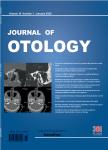Obstructive Sleep Apnea-Hypopnea Ssyndrome and Hearing in Children
Obstructive Sleep Apnea-Hypopnea Ssyndrome and Hearing in Children作者机构:Department of Otorhinolargygology Renmin Hospital of Jiangmen Department of Otorhinolargygology The 2nd Affiliated Hospital Sun Yat–sen University GuangZhou China
出 版 物:《Journal of Otology》 (中华耳科学杂志(英文版))
年 卷 期:2008年第3卷第2期
页 面:116-120页
学科分类:1002[医学-临床医学] 100213[医学-耳鼻咽喉科学] 10[医学]
主 题:obstructive sleep apnea-hypopnea syndrome children auditory brainstem response otoacoustic emissions
摘 要:Objective To explore the relationship between hypoxemia and hearing in children with obstructive sleep apnea-hypopnea syndrome. Methods Auditory brainstem responses (ABRs) were recorded in 68 ears and distortion product otoacoustic emissions (DPOAEs) in 60 ears in children with OSAHS and type A tym-panograms, and in 30 ears in normal children. Results ABR latencies of waves I, III and V, and I-III, III-V and I-V intervals were not statistically different between OSAHS and normal children. Wave I latency was delayed in children with OSAHS compared to normal children3 (P 0.05). DPOAE amplitudes in children with mild OSAHS were lower than normal children at 8 kHz (P 0.05). DPOAEs were lower at 6 kHz and 8 kHz in children with moderate/severe OSAHS than normal children (P 0.05). Conclusion Cochlear function was affected when AHI was at or greater than 10/hour. ABR and DPOAE can be used to detect early changes in auditory function in children with OSAHS.



